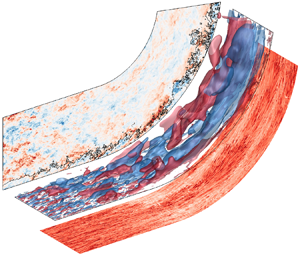Article contents
Concave-wall turbulent boundary layers without and with free-stream turbulence
Published online by Cambridge University Press: 08 March 2021
Abstract

Direct numerical simulations are performed to contrast turbulent boundary layers over a concave wall without and with free-stream turbulence. An adverse pressure gradient near the onset of curvature leads to a sharp decrease in skin friction and intermittent separation. The presence of free-stream turbulence reduces the probability of reverse flow, accelerates the recovery of the boundary layer in the downstream zero-pressure-gradient region, and leads to a sustained and appreciable increase in the skin friction. The forcing also promotes the amplification of coherent Görtler structures in the logarithmic layer of the curved-wall boundary layer. Statistically, the spanwise and wall-normal Reynolds stresses intensify and the radial distance between their peaks increases downstream as the Görtler structures expand. The Reynolds shear stress coefficient also increases in the logarithmic layer, in contrast to a decrease when a flat-plate boundary layer is exposed to free-stream turbulence. In addition, the more coherent and energetic roll motions in the forced flow promote mixing of free-stream and boundary-layer fluids, where the former is seen more often deep within the buffer layer.
JFM classification
- Type
- JFM Papers
- Information
- Copyright
- © The Author(s), 2021. Published by Cambridge University Press
References
REFERENCES
- 2
- Cited by





